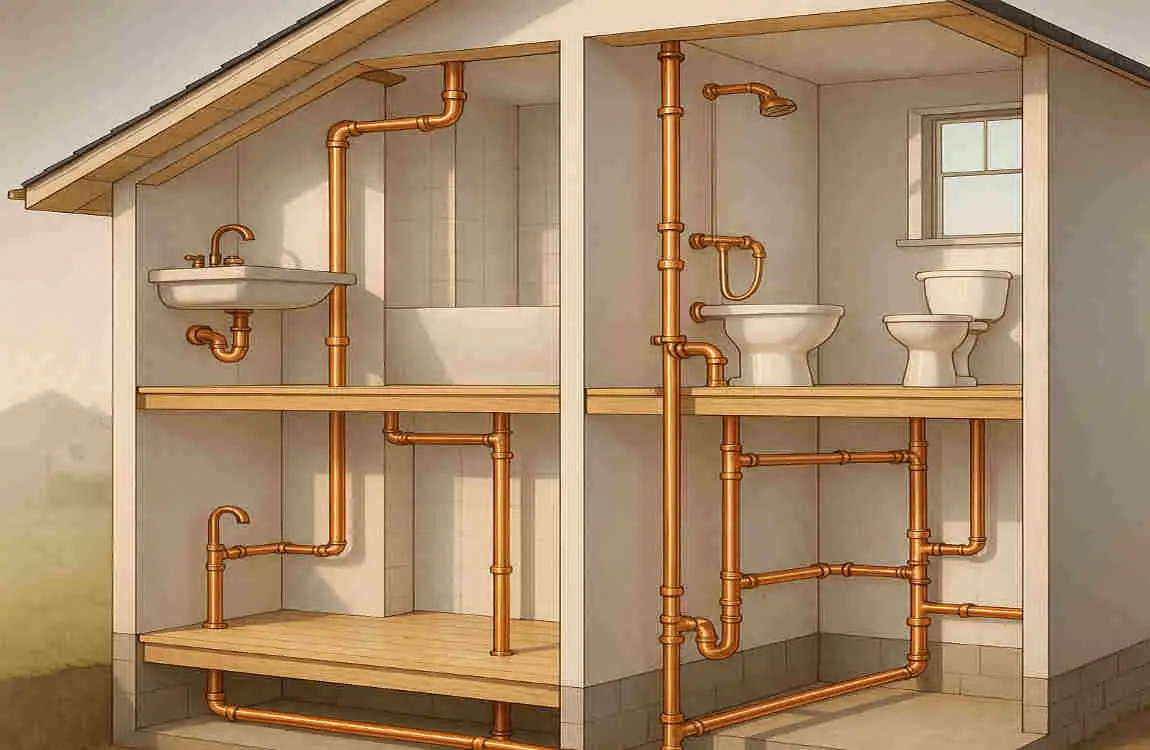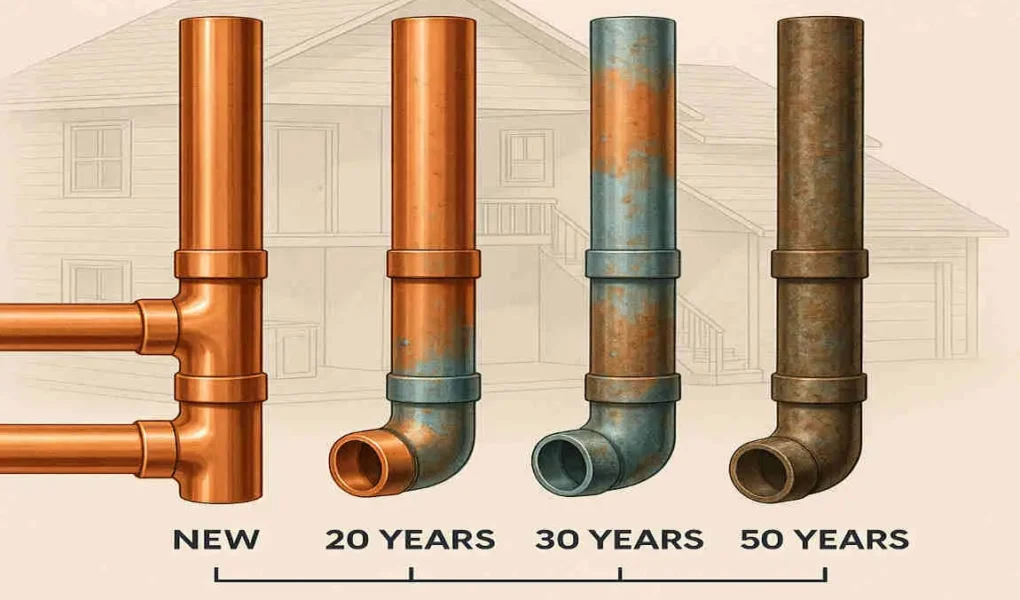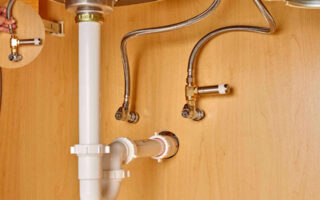Hey there, homeowner! If you’ve ever wondered about the pipes hiding behind your walls, you’re in the right place. Copper plumbing has been a go-to choice for homes across the U.S. for decades. It’s that reliable network of tubes carrying water to your faucets, showers, and appliances. But like everything in your house, it doesn’t last forever.
Understanding the lifespan of your house copper plumbing matters a lot. Think about it: leaky pipes can lead to costly repairs, water damage, or even health issues from poor water quality. That’s why so many people ask, How long does copper plumbing last? It’s a smart question, especially if you’re buying an older home or planning renovations.
What Is Copper Plumbing?

Copper plumbing might sound fancy, but it’s really just pipes made from copper metal. These pipes carry water throughout your house, from the main supply line to your kitchen sink or bathroom shower. Builders love using them because they’re rugged and reliable.
You’ll find copper pipes in all sorts of spots in a home. They handle hot and cold water supply, connect to your heating system (like radiators), and even work on some gas lines. If your house was built between the 1960s and early 2000s, chances are copper is what’s keeping the water flowing.
Not all copper pipes are the same, though. There are different types based on thickness and strength. Type K is the thickest and strongest, often used for underground lines where durability is key. Type L is a middle-ground option, great for most indoor water supply jobs. Type M is thinner and more affordable, making it perfect for low-pressure setups, such as some heating systems.
What makes copper stand out? It’s super durable, resisting wear and tear better than many alternatives. Plus, it fights off rust and buildup naturally – we call this corrosion resistance. Copper even has germ-fighting powers, meaning it helps keep your water cleaner by reducing bacteria growth. No wonder it’s a favourite for homeowners who want peace of mind.
Imagine flipping on your faucet and knowing your pipes won’t give out anytime soon. That’s the appeal of copper. But like any material, it has its limits, which brings us to the big question: how long does copper plumbing last?
How Long Does Copper Plumbing Last?
When people ask how long copper plumbing lasts, the answer isn’t one-size-fits-all. In most homes, copper pipes can keep going strong for 30 to 50 years. Sometimes, they even push past that, lasting 70 years or more with the proper care. That’s a solid run.
Compared to other materials, copper holds its own. For instance, PEX (a flexible plastic option) might last 25 to 40 years, while PVC (another plastic type) is in the same ballpark but can crack under extreme cold. Galvanised steel, an older choice, lasts 20 to 50 years but often rusts out faster.
Why does this matter to you? Knowing how long copper plumbing lasts helps with home maintenance. If your house is hitting the 40-year mark, it’s time to inspect those pipes. It could save you from surprise floods or expensive fixes during a renovation.
Of course, these numbers are averages. Your pipes might outlast the estimate if conditions are ideal, or they could fail sooner in a challenging environment. We’ll explore those factors next.
Factors Affecting Copper Plumbing Lifespan
Many things can influence how long copper plumbing lasts in your home. Let’s break them down one by one, so you can spot potential issues early.
Water Quality and Its Impact
First up: the water itself. If your water has a low pH (meaning it’s acidic), it can eat away at copper over time. High mineral content, like calcium or magnesium, builds up inside pipes, narrowing them and causing blockages.
You may also read (understanding wet vents a home plumbing guide).
Corrosive water is a big culprit, too. Think of it as water that’s too harsh, speeding up wear. If you live in an area with hard water, your pipes might not last as long as those in softer water zones.
Water Pressure and Temperature Changes
Ever notice how high water pressure makes your shower feel like a power wash? That force stresses pipes, leading to leaks. Aim for steady pressure around 40-60 psi to keep things safe.
Temperature swings matter too. Hot water expands pipes, and cold temperatures can cause them to crack. If your pipes aren’t insulated, winter could shorten their life.
Installation Quality and Pipe Type
The quality of the pipe installation plays a considerable role. Sloppy joints or wrong fittings invite problems. Thicker pipes like Type K last longer than thinner Type M ones, especially in high-demand spots.
Environmental and Usage Factors
Outside your home, soil conditions affect underground pipes – acidic soil corrodes copper faster. Climate counts: humid areas might promote moisture damage, while dry ones reduce it.
Inside, how much you use your plumbing affects wear. A big family with constant showers and laundry will stress pipes more than a single-person household.
Maintenance and Repairs
Finally, skipping upkeep shortens lifespan. Regular checks and quick fixes keep minor issues from becoming big ones. Neglect them, and you’re looking at early replacement.
What about your home? Take a moment to think about your water quality or usage habits – could they be impacting your pipes?
Signs Your Copper Plumbing May Need Replacement

No one wants a plumbing disaster, but catching problems early can save you headaches. Here are key signs that your copper pipes might be on their last legs. Pay attention, and you could avoid a flood.
Visible corrosion shows up as greenish or blue stains on pipes – that’s copper reacting with water or air. If you spot it under sinks or in the basement, it’s a red flag.
Leaks or drips at joints mean seals are failing. Even small ones can waste water and damage walls.
A sudden drop in water pressure or brownish water could signal a buildup or holes inside pipes.
Frequent repairs? If you’re calling a plumber every few months for bursts, the system is wearing out.
Strange odours or metallic tastes in your water often indicate that corrosion is releasing particles into your supply.
If your home’s plumbing is over 50 years old, it’s time to inspect regardless.
Here’s a quick list of warning signs to watch for:
- Greenish stains on exposed pipes
- Persistent leaks at connections
- Low pressure or discoloured water
- Repeated fixes for the same issues
- Unusual smells or tastes
- Old age beyond 40-50 years
How to Extend the Lifespan of Copper Plumbing
Good news: You can stretch how long copper plumbing lasts with some simple steps. It’s all about proactive care. Let’s walk through practical tips.
Start with routine inspections. Check exposed pipes monthly for leaks or stains. Catching issues early prevents bigger problems.
Install a water softener if your water is hard – it reduces mineral buildup that clogs pipes.
Filter your water to balance pH and remove corrosives. This keeps the inside of pipes smooth.
Insulate pipes in cold areas to stop freezing. Foam wraps are cheap and effective.
Avoid dumping harsh chemicals down drains; they eat at copper. Use proper fittings during any DIY work.
Get professional inspections yearly. Experts spot hidden wear you might miss.
Here’s a numbered list of easy steps to follow:
- Inspect pipes regularly for early signs of trouble.
- Add a water softener or filter to improve water quality.
- Insulate against temperature extremes.
- Steer clear of corrosive cleaners and ensure tight fittings.
- Schedule pro check-ups to stay ahead.
By doing these, you could add years to your plumbing. What step will you try first?
Costs Involved With Copper Plumbing Replacement
Replacing copper plumbing isn’t cheap, but it’s often worth it for long-term savings. Expect to pay between $5,000 and $20,000 for a whole-home repipe, depending on the size.
Factors such as pipe length and your home’s square footage contribute to higher costs. Labour in urban areas adds more – think $50-$150 per hour.
Repairing leaks might cost $200-$1,000 each time, but if they’re frequent, replacing saves money overall.
Compared to alternatives like PEX (cheaper at $2,000-$10,000), copper’s upfront hit is higher but lasts longer.
Invest in quality materials and pros – skimping leads to early failures. Is your budget ready for this?
Copper Plumbing vs. Alternative Materials: Lifespan Comparison
Wondering how long copper plumbing lasts compared to other options? This table breaks it down.
Material, Typical Lifespan, Durability, Highlights, Cost Considerations
Copper 30-50 years, sometimes longer. Corrosion-resistant, durable, recyclable. Moderate to high upfront cost
PEX 25-40 years, Flexible, resistant to freeze damage, Lower upfront cost
PVC 25-40 years Affordable, corrosion resistant Lower cost, less durable
Galvanised Steel 20-50 years Prone to corrosion, less common now Higher maintenance cost
Copper often wins for reliability, but PEX is gaining fans for ease. Which suits your home?
Common Myths About Copper Plumbing Lifespan
Myths can confuse homeowners about how long copper plumbing lasts. Let’s bust a few and set the record straight.
Myth one: Copper pipes never corrode. Not true – acidic water or poor installation can cause rust-like damage over time.
Myth two: Copper lasts forever without any upkeep. Reality? Like your car, it needs regular care to hit that 50-year mark.
Myth three: All copper pipes have the same lifespan, no matter what. Wrong type, water quality, and usage make a big difference.
Facts show copper is rigid, but not invincible. Don’t fall for these – stay informed instead.
When to Consult a Professional Plumber
In older homes, don’t guess about plumbing health. Call a pro for an expert look – they use cameras to inspect inside pipes.
Expect a thorough check: They’ll test pressure, look for corrosion, and suggest fixes.
Act fast if you see bursts, major leaks, or odd water tastes. Delaying could lead to floods.
You deserve peace of mind – when’s the last time a plumber visited your place?
Environmental and Health Benefits of Copper Plumbing
Copper isn’t just durable; it’s good for the planet and your health. It naturally fights germs, reducing bacteria in your water.
Plus, copper is fully recyclable – unlike some plastics that end up in landfills.
It helps ensure safe drinking water, free from harmful buildup. Compared to alternatives, it’s a win for the environment.
Choosing copper? You’re making a wise, eco-friendly choice.
You may also read (how to understand od in house plumbing).




